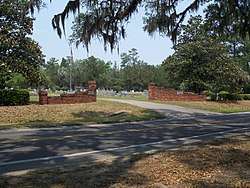Newnansville, Florida
The Newnansville Town Site was where the former town of Newnansville, Florida was located. Originally within Alachua County, in 1832 it became part of the newly formed Columbia County, but in 1839 it was restored as the county seat of Alachua. When it was realized that the Florida Railroad would bypass Newnansville, the county voted in 1854 to move the county seat to Gainesville, a newly founded railroad town. Bypassed again by another railroad in the late 1880s, Newnansville could not survive the competition. It was abandoned in the 20th century.
Newnansville Town Site | |
 Entrance to the Newnansville Cemetery, one of the few surviving remains of the town | |
| Location | Alachua County, Florida, USA |
|---|---|
| Nearest city | Alachua |
| Coordinates | 29°48′31″N 82°28′36″W |
| NRHP reference No. | 74000608[1] |
| Added to NRHP | December 4, 1974 |
The site is approximately 1.5 miles northeast of Alachua, Florida, on S.R. 235 off of US 441. Containing partial walls of two cemeteries, the town site was added to the National Register of Historic Places on December 4, 1974.
History
Bellamy Road
In 1824, only five years after Florida became a United States territory (and the same year that Alachua County itself was created), Congress authorized the construction of the first federal highway. It would connect Pensacola to St. Augustine. The Territorial Council commissioned John Bellamy, a Monticello planter, to build it. The project took two years to complete, at a cost of $20,000. The route would become known as Bellamy Avenue. It was a major highway until the Civil War, when other roads became preferred routes. A few of the places it passed were: the town of Traxler, the Santa Fe Taloca Spanish Mission, and what would become Newnansville.
Newnansville
The Dell brothers, who had earlier (during the "Patriot War") visited the Alachua County area, came back to settle there in 1814. They constructed a post office on the Bellamy Avenue in 1826, called Dell's, which became the nucleus of the new settlement.[2] In 1828, the Council named the small community Newnansville (in honor of a Patriot War hero, Daniel Newnan), and made it the county seat. "This was one of the richest land belts in north-central Florida."[3]
In 1832 Newnansville was included as part of the newly formed Columbia County, Florida, which extended north of Alachua.[3] With the outbreak of the Second Seminole War in 1835, many residents from around the area abandoned their farms and moved to the town or nearby Fort Gilliland for refuge. Women and men both worked to fortify the town's defenses, and families doubled up in crowded spaces. Some 300 people lived in tents outside the fort.[3]
In 1839, the legislature returned Newnansville to its role as county seat of Alachua County. A land office was established here in 1842, to make it easier for settlers to file claims, rather than having to go all the way to St. Augustine.[3] Following the end of the Seminole wars, the town flourished, becoming the center for trade and plantation life in the area. The county produced mainly corn and cotton in the antebellum years. It built a new courthouse in 1850.
The Florida Railroad Company announced its plan to build a line from Ferdinanda to Cedar Key, passing several miles south of Newnansville. In consequence, the county residents voted to move the county seat to a location along the planned route of the railroad, naming the new town Gainesville.[4] Losing the county seat marked the beginning of the end for Newnansville, as settlement moved south in the county. The town was directed to sell the courthouse in 1857, and it was used as a Masonic temple.[3]
After the Civil War farmers developed the citrus industry in the area. Two major factors contributed to the town's continuing decline. The Live Oak, Tampa and Charlotte Harbor Railroad, said to be connecting Newnansville to Gainesville, bypassed the town in 1883, building its line to the south.[3] In 1884 the town was bypassed again, when the Savannah, Florida, and Western Railroad constructed its line a mile and a half to the southwest. A new town, Alachua, grew up at a station stop there. In the winter of 1886, a major freeze ruined the area citrus crop. This major setback, plus the lack of railway connections, led businesses and residents to move to the growing communities of Alachua and Gainesville, and most went to the latter.
In 1896 Harry Jordan, an African-American man suspected of the murder of Dr. J.N. Cloud, was lynched and burned to death in Newnansville. He had taken shelter in a house, defending himself in a shootout with a white mob outside. They set the house on fire and he died.[5]
By the middle of the twentieth century, all the remaining buildings were razed. All that was left of Newnansville were two cemeteries and the remains of Bellamy Road, closed to traffic.[3]
References
- "National Register Information System". National Register of Historic Places. National Park Service. July 9, 2010.
- Forrester, Mary Lois. Lest We Forget, A Town, Newnansville, Florida. p. 19. OCLC 40544458.
- Susan Yelton, "Newnansville: A Lost Florida Settlement", The Florida Historical Quarterly, Vol. 53, No. 3 (Jan., 1975), pp. 319-331, via JSTOR; accessed 21 March 2018
- Charles H. Hildreth; Merlin G. Cox (1981). History of Gainesville, Florida 1854-1979. Gainesville, Florida: Alachua County Historical Society. pp. 2–6, 8.
- Dan, Nicole (27 September 2017). "At Least 21 Lynched In Alachua County, Historical Commission Confirms". WUFT-TV. Retrieved 9 January 2018.
External links
| Wikimedia Commons has media related to Newnansville, Florida. |
- Florida's Office of Cultural and Historical Programs - Alachua County
- Historic Markers in Alachua County"
- Natural and Historic Sites in Alachua County
- Tour Guide of Historic Alachua County
- History of Alachua
- Alachua County Library District Heritage Collection - Map of Newnansville
- Alachua County Scenic Roads - Old Bellamy Road

